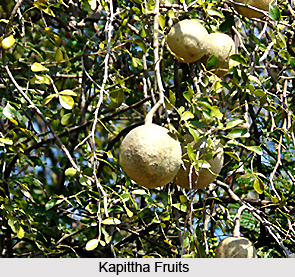 Kapittha is a medicinal plant which is scientifically known as Limonia acidissima L. There are several other vernacular names of this particular plant. For instance it is known as Kait in Bengali Language, katbel in Hindi Language, Bela in Kannada, Kaitha in Oriya Language, Karuvila in Tamil Language and Kaitha in Urdu. It is generally native to South India and is also found in the plains of India. The plant is also found in Sri Lanka and Java.
Kapittha is a medicinal plant which is scientifically known as Limonia acidissima L. There are several other vernacular names of this particular plant. For instance it is known as Kait in Bengali Language, katbel in Hindi Language, Bela in Kannada, Kaitha in Oriya Language, Karuvila in Tamil Language and Kaitha in Urdu. It is generally native to South India and is also found in the plains of India. The plant is also found in Sri Lanka and Java.
The plant is small to medium-sized deciduous tree with a straight trunk and more or less oval or rounded crown; bark whitish to pale or dark grey; lower branches armed with hard, axillary spines 1.2-3.7 cm long.
The leaves of the plant are alternate. The flowers are small, numerous, pale yellowish-green or dull red, borne in terminal or axillary panicles, male and female flowers often in the same panicle. It has a small calyx. The fruits are 5-8 cm in diameter, globose, with a grey, woody rind (pericarp). The numerous seeds of the plant are embedded in a soft, brown, strong-smelling, mealy pulp. Depending on locality, flowering occurs between February and June; fruits mature between September and December.
There are some medicinal properties which are associated with this plant the fruit is considered tonic, antiscorbutic, alexipharmic, astringent, stomachic and stimulant. Its pulp, as well as the powdered rind of the fruit, is applied externally as a remedy for the bites of venomous insects and reptiles. The unripe fruit paste is taken orally to check diarrhoea in southern Orissa. The bark is prescribed for biliousness. The leaves are aromatic, astringent and are used to treat digestive troubles in children. Among the tribal inhabitants of western Maharashtra, the leaf juice mixed with a pinch of black pepper is taken as a carminative. Oil is obtained by crushing the leaves are used to relieve itching. The pulp of the fruit is used to make jelly, chutney, and a pleasant drink.



















